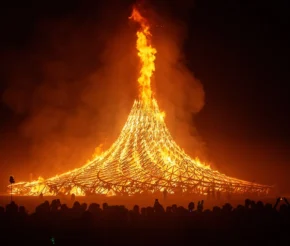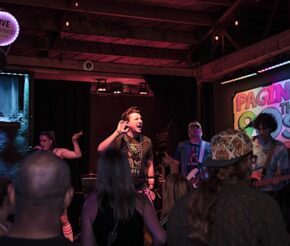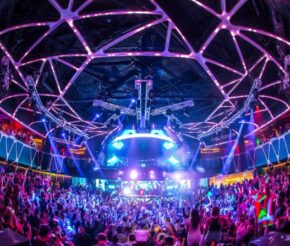- Advertise
-
Subscribe


What is a Crowd Surge?

Massive mobs and the lack of proper crowd control can quickly escalate from a vibrant hubbub to a recipe for disaster. Over 150 people and 100 were injured in Itaewon’s crowd surge when thousands of people gathered in the nightlife district to celebrate Halloween.
Now labeled as one of South Korea’s most tragic catastrophes, the mass casualty erupted when party-goers poured into Itaewon’s narrow, sloping alleyways.
This appalling scenario sounds a bit too familiar because last year, Astroworld Festival’s organizers learned what a crowd surge means the hard way.
In November 2021, the Astroworld fiasco took the lives of ten people after a tightly packed crowd rushed towards the stage where rapper and organizer Travis Scott was performing.
Many claim that the crowd surge could have been preventable, while others argue such disasters are unforeseeable and uncontrollable.
We decided to dive into the crowd surge phenomenon to find out the truth.
What is a crowd surge?
A crowd surge happens when a large group of people flicks, restricting space and free movement. Density builds up to the point where it is almost impossible to get out, and individuals lose their footing on the slope, causing a domino effect.
Contrary to popular belief, experts claim that the most common cause of death during a crowd surge is oxygen restriction, not injuries from getting trampled or pushed around.
During a crowd surge, too many people push in a confined area, either on the way in or trying to get out. The increasing pressure from both above and below can squeeze your body to the point where your lungs don’t have enough space to expand.
This leaves little to no chance for people caught in the crossfire to breathe.
Comprehensive asphyxiation is not the only bad thing that can happen. It takes no longer than 30 seconds of compression to restrict blood flow to the brain, which can make you lightheaded and ultimately faint.
In the densely packed environment of a crowd surge, obstructions are also caused by human piles made of people who pass out, trip, and get pushed aggressively enough to lose balance.
Deadly mobs and crowd surges have been around as long as humans have hosted large gatherings. Usually intensified in tightly-packed venues, crowd crushes are mostly identified with large-scale events such as concerts, music festivals, and clubs.
A similar crowd incident at American band Limp Bizkit’s 2001 Big Day Out concert ended with sheer chaos as revelers went into a frenzy upon the show starting.
Despite efforts by security to stop the concert upon the first signs of trouble, the band resisted and. The delay is believed to have been the reason for an attendee’s deadly asphyxiation.

Other incidents include The Who’s 1979 concert disaster. The math didn’t add up at this massive event either, as 18,348 tickets were sold and only 25 police officers were allotted for crowd control.
Large crowds gathered outside the Riverfront Coliseum, quickly growing agitated as the sold-out show was delayed. Eventually, crowds started pushing the glass doors, causing many to get jammed up so tight that they couldn’t get any air.
Why do crowd surges happen?
Primarily, the reason for crowd surges lies in the deadly combination of overcrowding and lack of proper control measures.
Mosh pits are not uncommon at concerts, and while these could result in their own kinds of serious injuries, crowd surges usually have more to do with organizers not taking the necessary safety precautions before the show.
It became clear that emergency plans for the Astroworld festival didn’t include protocols for dangerous crowd surges.
The responsibility of show organizers and local departments when planning a show of that capacity is to ensure that all safety and security measures are put in place beforehand.
What happened in the Seoul crowd crush is quite different from music festivals and scheduled events. When party-goers decided to celebrate the first major event that didn’t come with any pandemic-related strings attached to it, they didn’t have a ticket or elaborate itinerary.
Music festivals, gigs, and concerts work on a solid ecosystem where the number of attendees is known, overcrowding can be prevented with a “sold out event” banner, and ticket holders’ routes are obvious.

Those rules didn’t apply to Seoul’s catastrophic crowd crush. Local authorities were disarmed by their lack of knowledge regarding how many people would arrive, which direction they would go, and where the crowd densities would happen.
But crowd surges can still be prevented. Looking at the event’s space, analyzing the routes people might take, and implementing countermeasures to control a crowd crush serve as the risk assessment that could have saved hundreds of people if introduced at the right time.
Are crowd surges preventable?
It is no easy feat to control a crowd of hundreds – and usually thousands – of people. However, crowd surges can be preventable if the correct precautions are taken beforehand.
In the aftermath of the Astroworld events, many took to social media to do a #tbt of videos featuring performers who took the proper actions to stop possible disasters from unfolding.
Linkin Park have been praised for having the best response to seeing a fan getting trampled in the mosh pit.
Members Shinoda and Bennington reminded the crowd to pick people up if they saw anyone fall to the ground.
They encouraged the audience with the following chant: “If someone falls, what do we do? We pick them up.”
Another clip of Niall Horan stopping an Argentina show resurfaced, where the One Direction singer addresses the crowd and tells them to spread apart.
“Your security is my responsibility, okay? There is a ton of room down the back of this room. Everyone doesn’t need to be like this. And we don’t want anyone getting hurt or squashed.”
However, contrasting footage from Astroworld features performer Travis Scott noticing an ambulance rushing through the crowd to save injured concertgoers and then proceeding with the show.
Calls for the show to be stopped by fans were also ignored by stage crew, security, and the rap performer.


Crowd surges have proven deadly countless times throughout the history of live events, parades, and religious and cultural gatherings.
Event organizers and performers should go the extra mile to ensure necessary precautions are taken and protocols are followed to minimize the damage – and possibly nip a surge in the bud before it kicks off.
NEWSLETTER






 671
671 




